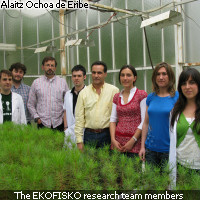How trees stay stress-free
As surprising as it may seem, humans are not the only victims of stress, plants are too. Changes in temperature or even too much light may lead to insufficient water levels which puts a lot of strain on plants. So what do plants do to protect themselves against stress? Scientists from the University of the Basque Country in northern Spain are studying the substances that are activated in plants for their protection. The research team has set its sights on determining which species, when faced with poor environmental conditions, can cope best during reforestation. Without a doubt, people cause harm to plants. Deforestation and arson have ravaged some of the world's most beautiful forested areas. But acts of Mother Nature � from extreme temperatures and shortages of rainfall to natural disasters � also influence the state of plants. Spring is the best season for plants because of the 'optimum conditions', where average humidity is adequate and temperatures are normal. Come summer and winter, however, plants must contend with dry spells as well as extreme temperatures. As a result, these changes trigger stressful situations for plants. In particular, trees cannot easily deal with excessive summer and winter light because they cannot absorb it all. Scientists call this 'photo-oxidative stress'. While some species of plants have the capacity to adapt to new situations and therefore deal with photo-oxidative stress, others do not. The research team from the Department of Plant Biology and Ecology at the University's Faculty of Science and Technology says that failure to dissipate any excessive energy causes the plants to deteriorate and die. The trees that successfully fight the problem do so by triggering chemical compounds that protect them, the EKOFISKO research team explains. Headed by Dr Txema Becerril, EKOFISKO seeks to uncover which defence mechanisms kick in when the plants seek protection. The team is studying the plants' behaviour in stressful conditions and is measuring their photo-protector substances. These substances are being used as biosensors of photo-oxidative stress, they say. The researchers have already succeeded in simulating summer and winter conditions in the greenhouse and in the growing rooms at the Faculty's site. These measures have enabled them to isolate each one of the stress agents and study its consequences. Long-cycle tree and other forest species are being studied. The scientists note that these plants must acclimatise properly to the environment before the reforestation process begins. They are evaluating species with ecological, economic or landscape interest, as well as the deciduous species and perennial varieties. The latest findings show that the hardiest plants are able to accumulate antioxidants including vitamin E and special carotenoids � a class of highly unsaturated yellow to red pigments found in plants � and can therefore dissipate excessive energy. With respect to climate change, the research team says the species that would initially feel the climate crunch is the autochthonous species of the Autonomous Community of the Basque Country (CAPV). In particular, plants in the southern area suffer most as this is where the Atlantic and Mediterranean regions meet.
Countries
Spain



